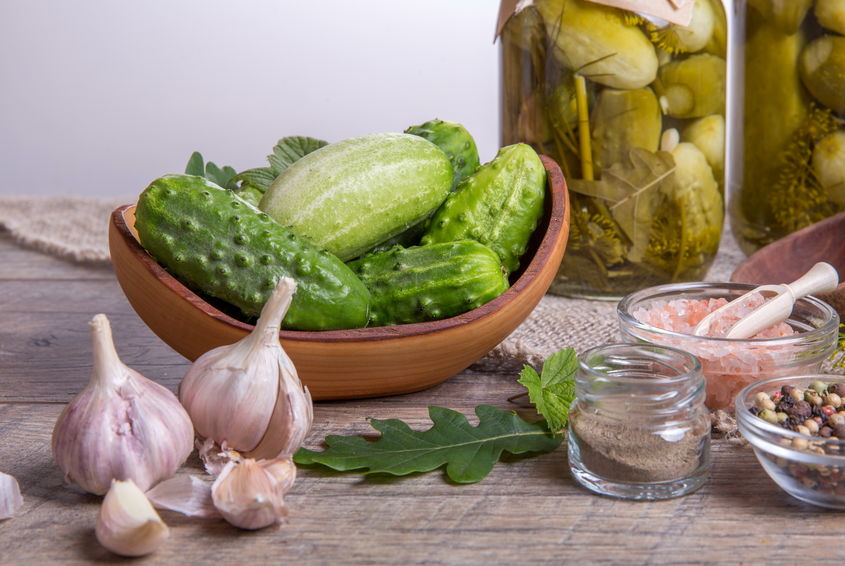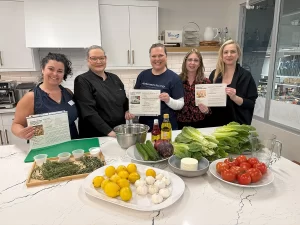
Time to Start Thinking About the Summer Surplus: Tips for Simple Food Preservation

With summer at its peak, many start thinking about what to do with all the surplus fruits and vegetables they have growing in the garden or the bushels and baskets soon available at your local Vince’s Market or farm fresh stand. Simple food preservation techniques are the answer—and it’s not just about jam and pickles either! All the produce plentiful in the summer months can be preserved with different methods to prolong their freshness and make them available for use over the winter.
While this topic may make some nervous with the lack of education, it’s truly an easy feat—our ancestors have used these methods for hundreds of years, refining them as new technologies became available and our contemporaries have been harkening back to the old ways while discovering new innovations along the way.
Pickles, Pickles, Pickles!
Pickles are so easy to make—it starts with making a brine and then waiting as the brine does all the work. You can tweak your brine as well with different spices and herbs to your own tastes—like things spicy? Add some red pepper flakes.
Want to think a little outside the box? Try pickling more than just cucumbers—green beans, carrots, beets, cabbage, asparagus, cauliflower, ginger, and radishes are a few of the many options available to you.
The Freezer Is Your Friend!
Many fruits and vegetables can be preserved in your freezer with minimal preparation. Whether they need to be scalded or blanched prior to laying them out flat on a cookie sheet to freeze separately or transferred into freezer bags–the method is dependent on what you’re preserving.
Don’t Forget the Salt!
Salt is a great preservative. You can use salt to preserve different herbs like basil for future use and lemons take on a concentrated flavour with less of the sour tartness most associate with the citrus fruit. And preserved lemons can change the intensity of any recipe calling for lemons—they are that good and totally worth the effort.
Preserving the bounty of summer doesn’t have to be hard work. Simple techniques employed at the peak of freshness can extend the lives of your fruits and vegetables through the fall and winter. Minimal expertise is required to start but a little fearlessness is essential—trust the processes tested by those who’ve come before you and you can’t really go wrong.
Time to Jam!
Making jam is the most adventurous many will get when it comes to food preservation. And that isn’t a bad thing—making jam can be simple, cost effective, and the result is delicious! Not only does it make a great hostess gift in the fall when you need something to take in a pinch, homemade jam just tastes better. Plus, you can control what you put into it, so you know what you’re feeding your family.
Better yet, you can play with flavours and make instant family favourites. How about blackberry jam with a hint of basil? Or peach jam with some added ginger? One of my personal favourites is apple jam with cinnamon, ginger, and cardamom—it has an inherent warmth to it reminiscent of warm apple crisp on a chilly fall evening. The combinations are endless and by playing with the fruit combinations and different herbs and spices, you can create magic in a jar.
Easy Homemade Jam (Without Pectin!)
Ingredients
- 4 cups fruit, roughly chopped (use whatever fruit you like!)
- 1 whole lemon, juiced
- 1/2 cup sugar
Instructions
- Toss all ingredients in a medium-sized, deep saucepan and turn the heat to medium until the mixture begins to bubble. Then, reduce the heat to simmer and stir.
- Allow mixture to cook and the fruit/berries to naturally break down. Be sure to stir every 20 minutes or so, even more frequently when the jam begins to thicken.
- When the jam has reached the consistency you desire, carefully pour hot jam into clean and sterile mason jars.
- Be sure the rim of the jar is clean and jam-free. Wipe the lid with a damp cloth, place on the seal. Tighten the lid until a slight resistance is met.
- Carefully place the jar on a kitchen towel where the jar will not be disturbed for twelve hours.
- Once the jam begins to cool, the seal will create a popping sound, assuring you that the jar is sealed.
- Refrigerate for immediate use or store in a cool dry place for up to six months.
We’d love to hear from you! What are your favourite preservation methods? Or do you have a fantastic recipe to share?? Leave us a comment here or head on over and join in the conversation on Facebook (please ‘Like’ the page if you’re so inclined) and Twitter. If you haven’t already signed up to receive our weekly newsletter which includes our blog, the weekly product feature, the weekly Coterie savings, and our recipe of the week delivered right to your inbox, you’ll find the signup by clicking here.
Let’s catch up soon,
Julie






